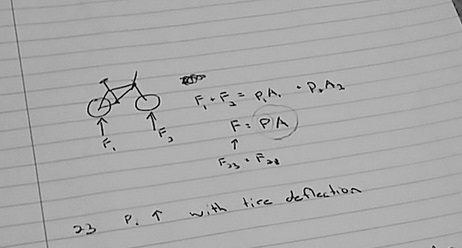Why wider tires offer less rolling resistance
Evan McNeely gets into the hard science of cycling by telling us why fatter tires—perhaps surprisingly—work better than their more slender counterparts.

by Evan McNeely
I still do maths when writing articles for @CDNCyclingMag. Brainstorming new input on tire volume vs resistance. pic.twitter.com/pXgdEez6Dz
— Evan McNeely (@evanmcneely) February 5, 2016
WorldTour cycling teams have been switching from 23mm-wide to 25mm-wide tires with the boastful claim that the latter have less rolling resistance. I wouldn’t blame you if you thought this sounds absurd. The idea that a bigger tire rolls faster is counterintuitive. There is, however, a lot of convincing evidence that wider is better.
Rolling resistance acts the same as friction, stripping energy out of system, producing heat or sound. Except, with rolling resistance, instead of two surfaces scraping against one another—a tire skidding against the ground, for example—rolling resistance is internal, caused by shear stress and hysteresis within the tire’s materials. Think of this as an “internal friction” of the tire when deformed at the contact patch. Greater deformation of the tire at the ground results in higher internal friction and poorer rolling performance.
Now, let’s look more closely at 23mm and 25mm tires. If both tires are inflated to the same pressure, then by physical law, the area of the contact patch of each tire has to be the same. The force from the ground pushing up on the tire is equal to the pressure within the tire multiplied by the area of the contact patch at the ground (Force = Pressure x Area). So if the rider is the same weight and the tires are inflated to the same pressure, the contact patch will always be the same size.
However, as can be seen in the figure below, the shape of the contact patch changes when moving to larger volume tires. This contact area becomes shorter and wider. The shape of the contact patch is the critical indicator of how much deformation and rolling friction the tire experiences. The 23mm tire sits lower to the ground, with a long and narrow contact patch, which causes the sidewalls to bulge. The 25mm tire sits higher on the ground, with less sidewall bulge and less energy loss.
Looking beyond a 25 mm tire, would you expect the rolling resistance of a fat bike slick to be higher or lower than that of the 25 mm tire?
If you said the fat bike has more rolling resistance, you would be wrong. If both the fat bike slick and the 25-mm road tire are inflated to the same pressure and have the same thickness and rubber composition, the fat bike slick will roll faster!
Obviously, WorldTour road teams won’t be jumping on to fat bikes anytime soon. The increased aerodynamic drag of fat tires greatly outweighs the rolling resistance benefit. Plus, it would be hard to get a fat bike tire inflated to 100 psi anyway. Then there’s the matter of the increased aerodynamic drag of wider tires. The drag of the 4″-wide fat bike tire would negate any rolling resistance benefit. The same might be said of 25mm tires over 23mm, but that’s another discussion for another article.

